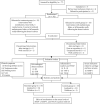Effect of Moxibustion on the Serum Levels of MMP-1, MMP-3, and VEGF in Patients with Rheumatoid Arthritis
- PMID: 33014110
- PMCID: PMC7519456
- DOI: 10.1155/2020/7150605
Effect of Moxibustion on the Serum Levels of MMP-1, MMP-3, and VEGF in Patients with Rheumatoid Arthritis
Abstract
Background: Rheumatoid arthritis (RA) is a chronic inflammatory autoimmune disease, which will eventually lead to joints deformity and functional damage. The aim of this research is to evaluate the effect of moxibustion on the serum indicators related to bone and cartilage metabolism, matrix metalloproteinase 1 (MMP-1), matrix metalloproteinase 3 (MMP-3), and vascular endothelial growth factor (VEGF) in patients with RA and to explore the mechanism of moxibustion in the treatment of RA.
Methods: We recruited 70 RA patients who met the inclusion criteria, and they were randomly divided into two groups, a treatment group and a control group in equal ratio. The control group took methotrexate, folate, or leflunomide orally, while the treatment group received methotrexate, folate, or leflunomide orally and moxibustion at ST36 (Zusanli), BL23 (Shen shu), and Ashi points. We compared the clinical symptoms, RA serological disease markers and serum contents of interleukin-1β (IL-1β), tumor necrosis factor-α (TNF-α), MMP-1, MMP-3, and VEGF of RA patients before and after treatment.
Results: (1) The clinical symptoms and RA serological disease markers of the two groups improved after treatment (P < 0.05), while the clinical symptoms of the treatment group were significantly improved in comparison with the control group (P < 0.05). (2) The levels of IL-1β, TNF-α, and VEGF decreased in both groups after treatment (P < 0.05), but the treatment group was significantly decreased compared with the control group (P < 0.05). (3) There were significant differences in MMP-1 and MMP-3 contents after treatment in the treatment group (P < 0.05, P < 0.05), while there were no significant differences in the control group (P > 0.05, P > 0.05). Above all, the contents of IL-1β, TNF-α, MMP-1, MMP-3, and VEGF in the treatment group decreased more significantly than those in the control group (P < 0.05).
Conclusion: The improvement effect of moxibustion on the clinical symptoms of RA patients may be related to influence on the contents of IL-1β, TNF-α, MMP-1, MMP-3, and VEGF, and moxibustion may play a potential role in bone protection.
Copyright © 2020 Zeyun Yu et al.
Conflict of interest statement
The authors declare that they have no conflicts of interest.
Figures



Similar articles
-
[Regulatory effect of moxibustion on LTB4/MMP-9 in serum of patients with rheumatoid arthritis].Zhen Ci Yan Jiu. 2023 May 25;48(5):488-93. doi: 10.13702/j.1000-0607.20220088. Zhen Ci Yan Jiu. 2023. PMID: 37247863 Clinical Trial. Chinese.
-
Effect of Moxibustion on HIF-1α and VEGF Levels in Patients with Rheumatoid Arthritis.Pain Res Manag. 2019 Nov 27;2019:4705247. doi: 10.1155/2019/4705247. eCollection 2019. Pain Res Manag. 2019. PMID: 31885755 Free PMC article. Clinical Trial.
-
Effect of Moxibustion on β-EP and Dyn Levels of Pain-Related Indicators in Patients with Rheumatoid Arthritis.Evid Based Complement Alternat Med. 2021 Apr 3;2021:6637554. doi: 10.1155/2021/6637554. eCollection 2021. Evid Based Complement Alternat Med. 2021. PMID: 33884025 Free PMC article.
-
[Effects of moxibustion on serum cytokines in experimental animals with rheumatoid arthritis: a systematic review and meta-analysis].Zhen Ci Yan Jiu. 2020 Sep 25;45(9):751-61. doi: 10.13702/j.1000-0607.190780. Zhen Ci Yan Jiu. 2020. PMID: 32959560 Chinese.
-
[Systematic reviews of effects of Tripterygium Glycosides Tablets on pro-inflammatory factors in rheumatoid arthritis].Zhongguo Zhong Yao Za Zhi. 2020 Feb;45(4):764-774. doi: 10.19540/j.cnki.cjcmm.20191024.401. Zhongguo Zhong Yao Za Zhi. 2020. PMID: 32237476 Chinese.
Cited by
-
Efficacy of thunder-fire moxibustion in treating ankylosing spondylitis of kidney deficiency and governor meridian cold and its influence on TNF-α and RANKL: study protocol for a prospective, nonblinded, single-center, randomized controlled trial.Trials. 2022 Apr 23;23(1):344. doi: 10.1186/s13063-022-06227-7. Trials. 2022. PMID: 35461283 Free PMC article.
-
Chrono-moxibustion adjusts circadian rhythm of CLOCK and BMAL1 in adjuvant-induced arthritic rats.Am J Transl Res. 2022 Jul 15;14(7):4880-4897. eCollection 2022. Am J Transl Res. 2022. PMID: 35958509 Free PMC article.
-
Moxibustion inhibits the macrophage M1 polarization toll-like receptor 4/myeloid differentiation factor 88/nuclear factor kappa B signaling pathway by regulating T-cell immunoglobulin and mucin-containing protein-3 in rheumatoid arthritis.J Tradit Chin Med. 2024 Dec;44(6):1227-1235. doi: 10.19852/j.cnki.jtcm.2024.06.009. J Tradit Chin Med. 2024. PMID: 39617708 Free PMC article.
-
Efficacy of Moxa-burning heat stimulating Zusanli (ST36) and Shenshu (BL23) on expressions of macrophage migration inhibitory factor and macrophage apoptosis in rabbits with adjuvant-induced arthritis.J Tradit Chin Med. 2022 Dec;42(6):980-987. doi: 10.19852/j.cnki.jtcm.20220817.001. J Tradit Chin Med. 2022. PMID: 36378057 Free PMC article.
-
Ebosin Attenuates the Inflammatory Responses Induced by TNF-α through Inhibiting NF-κB and MAPK Pathways in Rat Fibroblast-Like Synoviocytes.J Immunol Res. 2022 Mar 17;2022:9166370. doi: 10.1155/2022/9166370. eCollection 2022. J Immunol Res. 2022. PMID: 35340587 Free PMC article.
References
LinkOut - more resources
Full Text Sources

